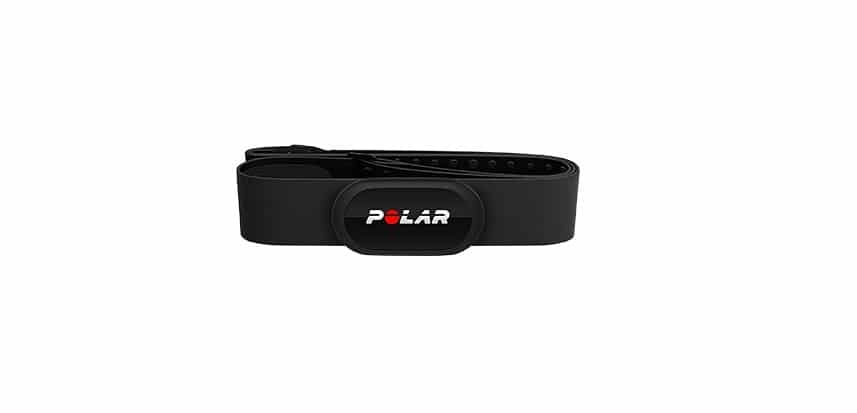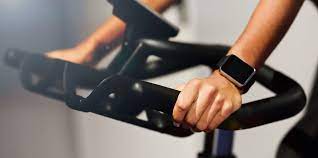Have Your Device on The Pulse of Each Workout
A heart rate monitor helps you get the best out of every workout session. Heart rate monitoring with a wearable heart rate tracker can help you keep up an optimum exercise intensity, increase your calorie burn, and maintain or improve your fitness levels. Whether you are casually riding on your Peloton bike or using other Peloton equipment like the company’s treadmill, a heart rate tracker takes the guesswork out of your workouts.
Your heart rate is measured by counting the number of times your heart beats every minute. Your heart rate increases when you have a fright, are stressed, or do aerobic (cardiovascular) exercise.
The harder you exercise, the faster your heart beats. To track the efficacy of your workouts, you need to know two numbers: your resting heart rate and your maximum heart rate. Your resting heart rate refers to the number of times a minute your heart beats when you are, well, resting. Your maximum heart rate is the highest number of beats your heart can safely beat in a minute. These numbers are slightly different for each person. Generally speaking, the more fit you are, the lower your heartbeat is (especially your resting heart rate).
Table Of Contents
You don’t need to use a heart rate monitor while you are exercising. You can exercise “by feel” while paying attention to the changes in your body. However, your workouts could be more effective and efficient when you use a Peloton heart rate monitor.
Your heart rate shows you how intensely you are working out. For example, suppose your goal is to become fitter, improve your cardiovascular (heart) health, and burn calories and fat. In that case, you need to keep your heart rate at an elevated level for extended periods of time.
On the other hand, it is easy to overexert yourself if you push it for too long. A heart rate monitor can help you find the balance.
The American College of Sports Medicine (ACSM), and other organizations, recommend that you do at least 20 to 60 minutes of aerobic exercise (that is, exercise that gets your heart pumping) three times a week. This amount is optimal regardless of your age or physical health. Keep in mind, though, that you always need to discuss your exercise routine with a medical professional and more so if you have any medical conditions or concerns.
In 1975, the ACSM defined an exercise prescription that included the “type, intensity, duration, frequency, and progression of physical activity.” This “prescription” is a guideline of how much exercise an individual needs to do, for how long, and how hard they need to work out. That means you will have a personalized target heart rate that you need to aim for each time you work out.
To calculate your maximum heart rate, subtract your age from 220. That means if you are 36, your maximum heart rate will be 184. Keep in mind that some factors could influence your maximum heart rate. For example, some medications (like medication that lowers your blood pressure) could lower your maximum heart rate. Age and medication are significant factors that affect your target heart rate zone. Check with your doctor or personal trainer if you are unsure.
According to the American Heart Association, moderate exercise intensity is between 50 and 70% of your maximum heart rate. Vigorous exercise is between 70 and 85% of your maximum heart rate.
If you are just starting out, you should aim to reach the lower end of your target heart rate zone and gradually increase the intensity of your workouts.
But, how do you calculate your zone? You can either do this with an online calculator or do the math on your own. First, you need to calculate your heart rate reserve (the difference between your resting heart rate and your maximum heart rate). You can find that by subtracting your resting heart rate (the number of times your heart beats per minute while you are relaxed and sitting still) from your maximum heart rate.
Next, multiply your heart rate reserve by the % range of your maximum heart rate required for a certain exercise intensity. This will be 0.5 for 50%, 0.7 for 70%, and 0.85 for 85%. Thus, if you want to engage in moderate activity, multiply your heart rate reserve by 0.5 and 0.7 to get the average target heart rate zone for moderate exercise. You can then use a heart rate monitor to track your heart rate and keep it in this zone while you work out.
Different types of heart rate monitors
Heart rate monitors for the sports industry became popular in the 1980s. These monitors consisted of dry electrodes that were attached to your chest. The electrodes were usually connected to a heart rate sensor (attached to the chest strap) and a radio receiver that you can wear on your wrist.
The electrodes and sensor pick up and measure the electrical signals that your heart gives off each time it beats. This heart rate data is then sent to the receiver, which displays your heart rate.
Although chest heart rate monitors are pretty accurate, they could be cumbersome. Recently, there have been advances in heart rate monitors that you can wear on your wrist. Wrist heart rate monitors are based on something called photoplethysmography (PPG). They essentially measure each “wave” of blood that gets pushed through your veins and arteries.
The drawback of wrist-worn heart rate monitors is that they may not always be accurate. Anything that affects how well the sensor makes contact with your skin could influence the measurements. Slight loss of contact occurs whenever you or the device moves, even just a little bit. This movement is natural and not entirely avoidable when you exercise. Micro-movements could also cause it in your tendons and your wrist shape.
The American National Standard (as set out by the American National Standards Institute) states the required accuracy of a heart rate meter. The ANS has said a heart rate monitor is accurate if it produces readings within 10% (or 5 beats per minute) of readings you would get with an electrocardiogram. An electrocardiogram is a device that accurately measures the electrical impulses produced by your heart.
Features to look for in a heart rate monitor
Compatible with Peloton equipment.
Peloton Interactive Inc. sells its own branded Peloton heart rate monitors. The Peloton heart rate band seamlessly connects with Peloton’s bikes and other Peloton devices. It also effortlessly links with the Peloton app.
Many other brands can connect to your Peloton bike via Bluetooth or ANT+ technology. ANT+ technology makes it possible for devices from different brands to talk to each other.

A heart rate monitor should quickly and easily pair with your Peloton bike to avoid frustrations. Chances are that if it’s a hassle to pair your devices, you will be less inclined to use them. Fortunately, ANT+ technology devices easily pair with other devices to make the most out of your fitness equipment and apps.
Although your Apple Watch does not have ANT+ technology, you can still use the device with your Peloton Bike or Tread. In this case, the watch will connect to your Peloton equipment via your iPhone or iPad. To do this, you will need to download the company’s iPhone workout app. From here, you will be able to manage and monitor data shared between your Peloton bike and iOS devices.
What you will be using it for
The type of heart rate monitor you prefer depends on the activities you will be using it for, how and where you want to wear it, and how accurate you need the readings to be.
Exercise heart rate monitors can typically be worn either strapped around your chest (secured with a chest strap) or on your wrist (like a watch or armband). Armband heart rate monitors are slightly less cumbersome and feel a bit less invasive. On the other hand, chest strap monitors provide more accurate readings.
At present, Peloton heart rate monitors are only wearable around your chest. However, there are rumors that the company is producing a wrist wearable heart rate monitor and fitness tracker.
Battery life and charging
Some heart rate monitors have replaceable batteries. In some cases, these batteries could last up to a year or longer, depending on how often you use the monitor and how long you use it. Other heart rate monitors have rechargeable batteries.
If you opt for an HR monitor with a rechargeable battery, consider how long the battery will last while it is turned on. Ideally, the battery should at least last as long as your longest planned workout time. You also need to consider how long it takes for the battery to charge fully. This will avoid the need to postpone or cancel your workout or workout without it because your heart rate monitor is taking too long to charge.
The most important features to consider are whether the device is comfortable to wear, whether it can connect via Bluetooth or ANT+ technology, and sufficient battery life. Whether you chose a chest strap or armband heart rate monitor is up to your personal preference.
Whether they use the bike, the tread, or enjoy other workouts on the company’s app, Peloton users will benefit from working out with a heart rate monitor.
References
- Best Heart Rate Monitor for Peloton: Do A Worthy Upgrade! (thebikersgear.com)
- Rumor: New Peloton Heart Rate Band to be launched (Peloton Heart Rate Monitor) - Peloton Buddy (pelobuddy.com)
- The Best Heart Rate Monitors for Peloton | Shape
- Best heart rate monitor for Peloton: Watches, chest straps and armbands | CNN
- How to Use a Heart Rate Monitor for Cycling (bicycling.com)
- The Ultimate Guide for Tracking Your Cycling Heart Rate | Wahoo Fitness
- The best heart rate monitors for the Peloton Bike and Tread - CNET
- How to Use Peloton Heart Rate Monitor? It's Simple! - The Bikers Gear
- Apple Watch FAQs - Peloton Support (onepeloton.com)
- Pairing Your Apple Watch With The Peloton Bike+ - Peloton Support (onepeloton.com)
- Peloton® | Bike Accessories (onepeloton.com)
- President’s Council on Sports, Fitness & Nutrition | health.gov
- Heart rate vs power meter | Which is best for training and racing? - BikeRadar
- Beginner’s guide: training with heart rate vs. ... (roadcyclinguk.com)
- How a Heart Rate Monitor Can Be Beneficial to Your Workouts - Health Essentials from Cleveland Clinic
- Your Fitness Tracker Isn’t the Best Way to Measure Heart Rate - Health Essentials from Cleveland Clinic
- What is ANT+ - THIS IS ANT
- Wrist-worn optical and chest strap heart rate comparison in a heterogeneous sample of healthy individuals and in coronary artery disease patients | BMC Sports Science, Medicine and Rehabilitation | Full Text (biomedcentral.com)
- Cardiac Monitor Guidance Cardiotachometer and Rate Alarm (fda.gov)
- Electrocardiogram: Procedure, Risks & Results (healthline.com)
- acsms-exercise-testing-prescription.pdf
- Physical Activity Guidelines Resources (acsm.org)
- Exercise intensity: How to measure it - Mayo Clinic
